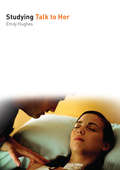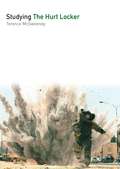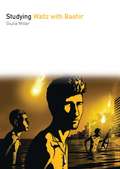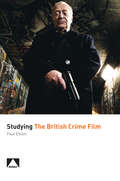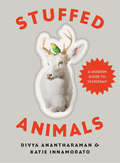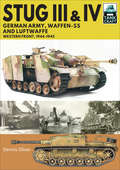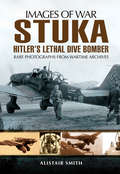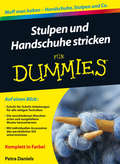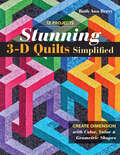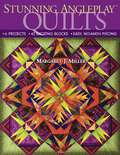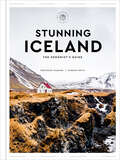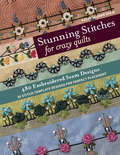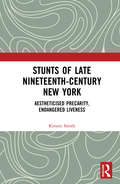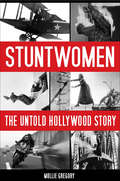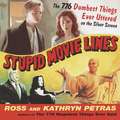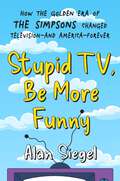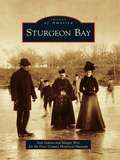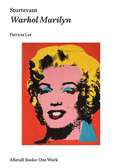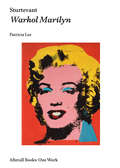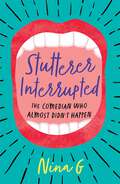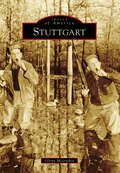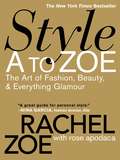- Table View
- List View
Studying Talk to Her (Studying Films)
by Emily HughesTalk to Her (2002) is a hugely rich and interesting though ambiguous film that met with both popular success and critical acclaim. The film won an Oscar for best original screenplay and has been hailed by some critics as Pedro Almodóvar's masterpiece. Yet like most of Almodóvar's films, little is clear cut. The characters are complex and our affinity and empathy for them shifts throughout the film. In Studying Talk to Her, Emily Hughes provides an in-depth analysis of both the formal elements of the film (its narrative, genre, and auteur study) and the themes and issues it raises, discussing the social context of modern Spain and its old, traditional iconography; shifting attitudes towards gender; and, crucially, the film's uneasy, morally ambiguous depiction of rape and the spectator's reaction to it.
Studying The Hurt Locker (Studying Films)
by Terence McSweeneyIn this vibrant and dynamic book-length study drawing on a broad tapestry of research, Terence McSweeney offers an exploration of The Hurt Locker (2009), its stylistic and narrative devices, its cultural impact, its reception, and its relationship to the genre of the war film. McSweeney places the film in a richly textured historical, political, and industrial context, arguing that The Hurt Locker is part of a long tradition of films about American wars that play a considerable role in how audiences come to understand the conflicts that they depict. Thus, films about a nation’s wars are never “only a movie” but rather should be considered a cultural battleground themselves on which a war of representation is waged.
Studying Waltz with Bashir (Studying Films)
by Giulia MillerOn its release in 2008, Ari Folman's animated documentary Waltz with Bashir was heralded as a brilliant and original exploration of trauma, and trauma's impact on memory and the recording of history. But it is surprising that although the film is seen through the eyes of one particular soldier, a viewpoint portrayed using highly experimental forms of animation, this has not prevented Waltz with Bashir from being regarded as both an 'autobiographical' and 'honest' account of the director's own experiences in the 1982 Lebanon war. In fact, the film won several documentary awards, and even those critics focusing on the representation of trauma suggest that this trauma must be authentic. In this sense, it is the documentary form rather than the animation that has had the most influence upon critics.As Studying Waltz with Bashir will show, it is the tension between the two forms that makes the film so complex and interesting, allowing for multiple themes and discourses to coexist, including Israel's role during the Lebanon War and the impact of trauma upon narrative, but also the representation of Holocaust memory and its role in the formation of Israeli identity. In addition to these themes that coexist by virtue of the film's unusual animated documentary format, Waltz with Bashir can also be discussed in relation to a broad range of contexts; for example, the representation of war in film, the history of Israeli Holocaust cinema, and recent trends in experimental animation, such as Richard Linklater's Waking Life (2001) and A Scanner Darkly (2006), as well as Folman's most recent live action/animation work The Congress (2013).
Studying the British Crime Film
by Paul ElliottEver since its inception, British cinema has been obsessed with crime and the criminal. One of the first narrative films to be produced in Britain, the Hepworth's 1905 short Rescued by Rover, was a fast-paced, quick-edited tale of abduction and kidnap, and the first British sound film, Alfred Hitchcock's Blackmail (1930), centered on murder and criminal guilt. For a genre seemingly so important to the British cinematic character, there is little direct theoretical or historical work focused on it. The Britain of British cinema is often written about in terms of national history, ethnic diversity, or cultural tradition, yet very rarely in terms of its criminal tendencies and dark underbelly. This volume assumes that, to know how British cinema truly works, it is necessary to pull back the veneer of the costume piece, the historical drama, and the rom-com and glimpse at what is underneath. For every Brief Encounter (1945) there is a Brighton Rock (2010), for every Notting Hill (1999) there is a Long Good Friday (1980).
Studying the British Crime Film (Studying British Cinema Ser.)
by Paul ElliottEver since its inception, British cinema has been obsessed with crime and the criminal. One of the first narrative films to be produced in Britain, the Hepworth’s 1905 short Rescued by Rover, was a fast-paced, quick-edited tale of abduction and kidnap, and the first British sound film, Alfred Hitchcock’s Blackmail (1930), centered on murder and criminal guilt. For a genre seemingly so important to the British cinematic character, there is little direct theoretical or historical work focused on it. The Britain of British cinema is often written about in terms of national history, ethnic diversity, or cultural tradition, yet very rarely in terms of its criminal tendencies and dark underbelly. This volume assumes that, to know how British cinema truly works, it is necessary to pull back the veneer of the costume piece, the historical drama, and the rom-com and glimpse at what is underneath. For every Brief Encounter (1945) there is a Brighton Rock (2010), for every Notting Hill (1999) there is a Long Good Friday (1980).
Stuffed Animals: A Modern Guide to Taxidermy
by Divya Anantharaman Katie InnamoratoA quirky, timely, and disturbingly beautiful how-to taxidermy guide, emphasizing ethical sourcing and personal expression Whether inspiration came from an exhibition at an edgy art gallery, a visit to the Natural History Museum, or the sight of your crazy uncle’s jackalope, more and more people are opening up to the fun and wonder of taxidermy. A mix of art, science, and a touch of alchemy, taxidermy lets you engage with the natural world in ways most other people don’t. In Stuffed Animals, Divya Anantharaman and Katie Innamorato demystify the practice, shatter the gross stereotypes, and make taxidermy accessible to anyone, anywhere. Committed to ethical and sustainable sourcing, Anantharaman and Innamorato are part of the vanguard of young taxidermists who bring a sense of fun and experimentation to this old-school hobby. In their sold-out classes in Brooklyn, they teach hundreds of taxidermy novices how to create mantle-worthy pieces out of small birds and mammals. Both a helpful how-to manual and a strangely captivating gift book, Stuffed Animals is the definitive guide to a growing movement.
Stug III & Stug IV: German Army, Waffen-SS and Luftwaffe: Western Front, 1944–1945 (TankCraft)
by Dennis OliverA guide that blends the history behind this German World War II tank with resources for military vehicle modeling enthusiasts. In the last years of the Second World War the Sturmgeschütz III (StuG III) and Sturmgeschütz IV (StuG IV) played a vital role as assault guns during the German army&’s struggle to block the Allied advance on the Western Front. As the Wehrmacht&’s tank forces declined, these armored vehicles were thrown into every defensive operation. They are not as well-known as the Tigers and Panthers, but German resistance would have been much weaker without them. They were also among the most frequently encountered German armored vehicles on the battlefields, which is why they are such a fascinating subject for Dennis Oliver in this volume in the TankCraft series He uses archive photos and extensively researched color illustrations to examine the StuG III and StuG IV deployed by the German army and the Waffen-SS during these doomed campaigns. A key section of his book displays available model kits and aftermarket products, complemented by a gallery of beautifully constructed and painted models in various scales. Technical details as well as modifications introduced during production and in the field are also examined providing everything the modeler needs to recreate an accurate representation of these historic armored vehicles.
Stuka: Hitler's Lethal Dive Bomber (Images of War)
by Alistair Smith&“A very nice release about the most recognizable German aircraft of the Second World War&” from the author of Rommel&’s Army in the Desert (Inscale.org). The photographs in this collection belonged to Luftwaffe Stuka rear gunner and radio operator Erich Heine. The collection includes photographs of flights of Stukas in formation, operating training aircraft, and a selection of different Luftwaffe uniforms and flight gear. The photographer was based for a period in Czechoslovakia, was shot down over the Ukraine in August 1943 and for a time was listed as missing in action. This collection offers a unique insight into the German experience of World War Two, providing the opportunity to access materials that have never been published before&“The book very ably documents the war career of the aircraft and the pilots, reproducing some outstanding images of war.&” —Firetrench&“The most remarkable thing about this album is that it contains photographs of perhaps the most famous Stuka ace, Hans-Ulrich Rudel.&” —Inscale.org&“The photographs . . . show the life of Erich and Luftwaffe Stuka crew members through training/deployment/leave and include funerals of squadron members . . . The narrative gives a good overview of the Stuka in service and the photographs show varied views of the aircraft and day to day life within the squadron.&” —WW2 Talk
Stulpen und Handschuhe stricken für Dummies (Für Dummies)
by Petra DanielsAnfänger werden Schritt für Schritt in die Grundlagen des Strickens eingeführt und lernen alle nötigen Techniken, um die Projekte nacharbeiten zu können. Dabei bauen die Projekte in ihrem Schwierigkeitsgrad aufeinander auf: Anfänger können sehr bald einen Muff oder Pulswärmer fertigen. Wer Vorkenntnisse hat, kann bei seinem Kenntnisstand einsteigen oder sich inspirieren lassen. Neben den leicht verständlichen Anleitungen enthält das Buch viele Tipps und Anregungen für individuelle Fäustlinge, Fingerhandschuhe und Co. Warme Basics oder für jedes Outfit ein modisches Accessoire? Dieses Buch macht es möglich.
Stunning 3-D Quilts Simplified: Create Dimension with Color, Value & Geometric Shapes
by Ruth Ann BerryLearn how to sew three-dimensional illusions with these twelve quilt projects.Create a stunning quilt that will have your friends asking, “How did you do that?” Believe it or not, these attention-grabbing projects come together with straight rows of simple shapes. You’ll learn how to sew twelve visually arresting quilts each in four colorways giving you dozens of dynamic options. Build your confidence in bias piecing, as you pair light, medium, and dark fabrics for heavenly hexes. Don’t be intimidated—just follow the easy assembly diagrams and watch your quilt come together one row at a time with no inset seams. These 3-D illusions are so impressive, you won’t know whether to keep them on the bed or hang them on the wall. Sew 3-D illusion quilts that have your friends asking how you did itArrange sixty-degree triangles in rows for easy piecing with no inset seamsBuild your confidence in bias piecing, mixing color values for dimensional effects
Stunning AnglePlay Quilts
by Margaret J. MillerTurn Long Triangles into Vibrant Quilts the Easy AnglePlay™ Way • 42 dazzling blocks with easy-to-use cutting charts, piecing illustrations, and full-size template patterns • 6 eye-catching quilts with complete patterns and instructions • Mix and match blocks into your own dynamic quilts • Use AnglePlay™ plastic templates or make your own with the included template patterns Step out of the ordinary and into a whole new world of piecing possibilities with quilts made from half-rectangle triangles. Margaret's AnglePlay™ method makes them a breeze to cut and piece. You'll create quilts with a sense of life, movement, and elegant curves, even though all the piecing is in easy straight lines. *Important Note about PRINT ON DEMAND Editions: This title will be printed after purchase and will arrive separately from any in-stock items. Please allow approximately 2 weeks for USA delivery, with an additional 2 weeks for international shipments. Expedited shipping is not available on POD Editions. The printing quality in this copy will vary from the original offset printing edition and may look more saturated due to printing on demand by a high-quality printer on uncoated (non-glossy) paper. The information presented in this version is the same as the most recent printed edition. Any pattern pullouts have been separated and presented as single pages.
Stunning Iceland: The Hedonist's Guide
by Bertrand Jouanne Gunnar FreyrGo beyond the ordinary with this remarkable travelogue, guidebook, and coffee table keepsake filled with spectacular color photography that showcases Iceland’s stunning beauty and hidden gems, from its fjords and highlands to the Western Islands and the capital Reykjavik—the first entry in the Hedonist’s Guide travel series.Combining essential insider details, cultural information, must-see attractions, and detailed maps with glorious custom photography, Stunning Iceland is the ultimate handbook for modern nomads, including both savvy travelers and novice tourists. Designed for twenty-first century globetrotters, Stunning Iceland features stylish graphics and an elegant visual design, as well as a breakdown of must-visit places, thematic double-page photographic spreads to help you discover and understand the city, and walking routes to explore each district away from the crowds. Whether you prefer a more traditional visit or want to chart your own unique course, this user-friendly handbook includes everything you need—and more:Discover the charm of a luxury ecolodge surrounded by natureMeet the surfers of the ArcticTaste the new Nordic gastronomyFollow in the footsteps of the heroes of the Icelandic sagasMeet the polar fox and the blue whaleBathe in the natural hot springsAdmire the Icelandic floraLearn about the battle between the tectonic plates beneath Iceland and its active volcanoesExperience Reykjavík, the nation’s beating heart Stunning Iceland offers inspiration and insight for armchair travelers and dreamers alike. Best of all, the gorgeous photography transforms the book into a keepsake that will transport you back to your favorite places and sights long after returning home.Experience Iceland as never before with the Hedonist’s Guide!
Stunning Stitches for Crazy Quilts: 480 Embroidered Seam Designs, 36 Stitch-Template Designs for Perfect Placement
by Kathy Seaman ShawFind endless inspiration for stitching your crazy quilts in this treasure trove of seam designs and templates by the creator of Shawkl Designs.You don't have to be a master embroiderer to create beautiful crazy-quilt seams! With 480 seam designs to inspire your creativity, Stunning Stitches for Crazy Quilts will also teach you the simple techniques that give your stitches a professional appearance. Line everything up perfectly with full-size stitch templates and dozens of step-by-step illustrations. Then dress up embroidered seams with sparkly beads, buttons, sequins, and silk ribbon embellishments for endless creative combinations!This eBook edition includes links to printable full-size templates.
Stunts of Late Nineteenth-Century New York: Aestheticised Precarity, Endangered Liveness
by Kirstin SmithStunts of Late Nineteenth- Century New York: Aestheticised Precarity, Endangered Liveness examines the emergence of stunts in the media, politics, sport and art of New York at the turn of the twentieth century. This book investigates stunts in sport, media and politics, demonstrating how these risky performances tapped into anxieties and fantasies concerning work, freedom, gendered/ raced/ classed bodies and the commodifi cation of human life. Its case studies examine bridge jumping, extreme walking contests, stunt journalists such as Nellie Bly, and cycling feats including Annie Londonderry’s round- the- world venture. Supported by extensive archival research and Performance Studies theorisations of precarity, liveness and surrogation, Smith theorises an under- examined form which is still prevalent in art, politics and commerce, to show what stunts reveal about value, risk and human life. Suitable for scholars and practitioners across a range of subjects, from Performance Studies to gender studies, to media studies, Stunts of Late Nineteenth- Century New York explores how stunts turned everyday precarity into a spectacle.
Stuntwomen: The Untold Hollywood Story (Screen Classics)
by Mollie Gregory“Gives voice to the women who have risked their lives for a few (perilous) moments on the big screen. A fascinating look at a risky profession.” —The Washington PostThey’ve traded punches in knockdown brawls, crashed biplanes through barns, and raced to the rescue in fast cars. They add suspense and drama to the story, portraying the swimmer stalked by the menacing shark, the heroine dangling twenty feet below a soaring hot air balloon, or the woman leaping nine feet over a wall to escape a dog attack. Only an expert can make such feats of daring look easy, and stuntwomen with the skills to perform—and survive—great moments of action in movies have been hitting their mark in Hollywood since the beginning of film.Here, Mollie Gregory presents the first history of stuntwomen in the film industry from the silent era to the twenty-first century. In the early years of motion pictures, women were highly involved in all aspects of film production, but they were marginalized as movies became popular, and more important, profitable. Capable stuntwomen were replaced by men in wigs, and very few worked between the 1930s and 1960s. As late as the 1990s, men wore wigs and women’s clothes to double as actresses, and were even “painted down” for some performances, while men and women of color were regularly denied stunt work.For decades, stuntwomen have faced institutional discrimination, unequal pay, and sexual harassment even as they jumped from speeding trains and raced horse-drawn carriages away from burning buildings. Featuring sixty-five interviews, Stuntwomen showcases the absorbing stories and uncommon courage of women who make their living planning and performing action-packed sequences that keep viewers’ hearts racing.
Stupendous, Miserable City: Pasolini’s Rome
by John David RhodesJohn David Rhodes places the city of Rome at the center of this original and in-depth examination of the work of Italian director Pier Paolo Pasolini—but it&’s not the classical Rome you imagine. Stupendous, Miserable City situates Pasolini within the history of twentieth-century Roman urban development. The book focuses first on the Fascist period, when populations were moved out of the urban center and into public housing on the periphery of the city, called the borgate, and then turns to the progressive social housing experiments of the 1950s. These environments were the settings of most of Pasolini&’s films of the early to mid-1960s. Discussing films such as Accattone, Mamma Roma, and The Hawks and the Sparrows, Rhodes shows how Pasolini used the borgate to critique Roman urban planning and neorealism and to draw attention to the contemptuous treatment of Rome&’s poor. To Pasolini, the borgate, rich in human incident, linguistic difference, and squalor, &“were life&”—and now his passion can be appreciated fully for the first time. Carefully tracing Pasolini&’s surprising engagement with this part of Rome and looking beyond his films to explore the interrelatedness of all of Pasolini&’s artistic output in the 1950s and 1960s—including his poetry, fiction, and journalism—Rhodes opens up completely new ways of understanding Pasolini&’s work and proves how connected Pasolini was to the political and social upheavals in Italy at the time. John David Rhodes is lecturer in literature and visual culture at the University of Sussex.
Stupid Movie Lines: The 776 Dumbest Things Ever Uttered on the Silver Screen
by Ross Petras Kathryn PetrasThe creme de la crud of screen history "War! War! That's all you think of, Dick Plantagenet! You burner! You pillager!" --Virginia Mayo as Lady Edith to George Sanders in King Richard and the Crusaders (1954) "Visits? That would indicate visitors. " --Army captain learning of alien visits in Plan 9 from Outer Space (1959) "When I'm sitting here with you, I don't even think about the slime people. " --Hero to heroine in The Slime People (1962) "Suck the coffin mushroom now. " --The Ultimate Vampire (1991) "This is bad. " --Leonardo DiCaprio as the you-know-what hits the you-know-what in Titanic (1997)
Stupid TV, Be More Funny: How the Golden Era of The Simpsons Changed Television-and America-Forever
by Alan SiegelThis comprehensive account of the meteoric rise of The Simpsons combines incisive pop culture criticism and interviews with the show&’s creative team that take readers inside the making of an American phenomenon during its most influential decade, the 1990s.The Simpsons is an American institution. But its status as an occasionally sharp yet ultimately safe sitcom that's still going after 33 years on the air undercuts its revolutionary origins. The early years of the animated series didn't just impact Hollywood, they changed popular culture. It was a show that altered the way we talked around the watercooler, in school hallways, and on the campaign trail, by bridging generations with its comedic sensibility and prescient cultural commentary. In Stupid TV, Be More Funny, writer Alan Siegel reveals how the first decade of the show laid the groundwork for the series' true influence. He explores how the show's rise from 1990 to 1998 intertwined with the supposedly ascendent post-Cold War America, turning Fox into the juggernaut we know today, simultaneously shaking its head at America's culture wars while finding itself in the middle of them. By packing the book with anecdotes from icons like Conan O&’Brien and Yeardley Smith, Siegel alaso provides readers with an unparalleled look inside the making of the show. Through interviews with the show's legendary staff and whip-smart analysis, Siegel charts how The Simpsons developed its singular sensibility throughout the &‘90s, one that was at once groundbreakingly subversive for a primetime cartoon and shocking wholesome. The result is a definitive history of The Simpsons' most essential decade.
Sturgeon Bay
by Door County Historical Museum Ann Jinkins Maggie WeirStretching midway across Wisconsin's famous Door County peninsula, Sturgeon Bay has developed into the county's business and industrial center. Divided by the waterway it's named after, this small city provided a home to a working waterfront that once housed sawmills and docks for shipping ice, quarried stone, and, later, cherries. A canal dug from Sturgeon Bay to Lake Michigan in 1880 enabled ships to avoid the long passage over the tip of the peninsula. Sturgeon Bay became a shipbuilding capital, housing three major yards. The lively downtown districts on each side of the bay sported the typical hotels, taverns, stores, and blacksmith shops. Residents took pride in their newly formed schools, churches, and public services such as the Pioneer Fire Department. Families, fortunate to live in a land of great natural beauty, enjoyed recreational pursuits in the woods and on the water, whether it was perch fishing early on a summer morning or skating over the ice on a crisp winter afternoon.
Sturgis' Illustrated Dictionary of Architecture and Building: An Unabridged Reprint of the 1901-2 Edition, Vol. II
by Francis A. Davis Russell SturgisVolume 2 of monumental 3-volume classic offers comprehensive and detailed coverage of architectural terms, individuals and national styles. Total in set: over 100 photographs and more than 1000 illustrations. Bibliography.
Sturtevant: Warhol Marilyn
by Patricia LeeWarhol Marilyn (1965) is not a work by Andy Warhol but by the artist Elaine Sturtevant (1930--2014). Throughout her career, Sturtevant (as she preferred to be called) remade and exhibited works by other contemporary artists, among them Jasper Johns, Roy Lichtenstein, and Robert Rauschenberg. For Warhol Marilyn, Sturtevant used one of Warhol's own silkscreens from his series of Marilyn printed multiples. (When asked how he made his silkscreened work, Warhol famously answered, "I don't know. Ask Elaine.") In this book, Patricia Lee examines Warhol Marilyn as representing a shift in thinking about artistic authorship and originality, highlighting a decisive moment in the rethinking of the contemporary artwork.Lee describes the cognitive dissonance a viewer might feel on learning the identity of Warhol Marilyn's author, and explains that mistaken identity is part of Sturtevant's intention for the operation of the work. She discusses the ways that Sturtevant's methodology went against the grain of a certain interpretation of modernism, and addresses the cultural significance of both Warhol and Monroe as celebrity figures. She considers Dorothy Podber's shooting a bullet through a stack of Warhol's Marilyns (thereafter known as The Shot Marilyns) at the Factory in 1964 and its possible influence on Sturtevant's decision to remake the work. Lee writes that Sturtevant's critical reception has been informed by some fictional forebears: the made-up artist Hank Herron (whose nonexistent work duplicating paintings by Frank Stella was reviewed by a fictional critic), and (suggested by Sturtevant herself) Pierre Menard, the title character of Jorge Luis Borges's "Pierre Menard, Author of the Quixote," who recreates a section of Cervantes's masterpiece line by line. And finally, she explores installation contexts and display strategies for Sturtevant's work as illuminating her broader artistic aims and principles.
Sturtevant: Warhol Marilyn (One Work)
by Patricia LeeAn illustrated examination of a work—a Warhol that isn't by Warhol—that embodies a shift in attitudes about artistic authorship and originality. Warhol Marilyn (1965) is not a work by Andy Warhol but by the artist Elaine Sturtevant (1930–2014). Throughout her career, Sturtevant (as she preferred to be called) remade and exhibited works by other contemporary artists, among them Jasper Johns, Roy Lichtenstein, and Robert Rauschenberg. For Warhol Marilyn, Sturtevant used one of Warhol's own silkscreens from his series of Marilyn printed multiples. (When asked how he made his silkscreened work, Warhol famously answered, “I don't know. Ask Elaine.”) In this book, Patricia Lee examines Warhol Marilyn as representing a shift in thinking about artistic authorship and originality, highlighting a decisive moment in the rethinking of the contemporary artwork. Lee describes the cognitive dissonance a viewer might feel on learning the identity of Warhol Marilyn's author, and explains that mistaken identity is part of Sturtevant's intention for the operation of the work. She discusses the ways that Sturtevant's methodology went against the grain of a certain interpretation of modernism, and addresses the cultural significance of both Warhol and Monroe as celebrity figures. She considers Dorothy Podber's shooting a bullet through a stack of Warhol's Marilyns (thereafter known as The Shot Marilyns) at the Factory in 1964 and its possible influence on Sturtevant's decision to remake the work. Lee writes that Sturtevant's critical reception has been informed by some fictional forebears: the made-up artist Hank Herron (whose nonexistent work duplicating paintings by Frank Stella was reviewed by a fictional critic), and (suggested by Sturtevant herself) Pierre Menard, the title character of Jorge Luis Borges's “Pierre Menard, Author of the Quixote,” who recreates a section of Cervantes's masterpiece line by line. And finally, she explores installation contexts and display strategies for Sturtevant's work as illuminating her broader artistic aims and principles.
Stutterer Interrupted: The Comedian Who Almost Didn't Happen
by Nina G.Nina G bills herself as “The San Francisco Bay Area’s Only Female Stuttering Comedian.” On stage, she encounters the occasional heckler, but off stage she is often confronted with people’s comments toward her stuttering; listeners completing her sentences, inquiring, “Did you forget your name?” and giving unwanted advice like “slow down and breathe” are common. (As if she never thought about slowing down and breathing in her over thirty years of stuttering!) When Nina started comedy nearly ten years ago, she was the only woman in the world of stand-up who stuttered—not a surprise, since men outnumber women four to one amongst those who stutter and comedy is a male-dominated profession. Nina’s brand of comedy reflects the experience of many people with disabilities in that the problem with disability isn’t in the person with it but in a society that isn’t always accessible or inclusive.
Stuttgart (Images of America)
by Glenn MosenthinStuttgart was founded in 1880 by a colony of German Lutherans who moved from Ohio to Arkansas's Grand Prairie. The city grew steadily after the Cotton Belt Railroad arrived in 1883. A group of realtors promoted Stuttgart to residents of Midwestern states, attracting a large population influx. Initially, the main income sources were hay and cattle, but that changed forever after rice was successfully grown near Stuttgart. The first rice mill was built in 1907, followed in 1921 by the creation of a farmers' cooperative that is now the world's largest rice processor and marketer. By the 1930s, Stuttgart's location on the Mississippi Flyway, along with abundant surface water, led to its renown as a waterfowl hunter's paradise. The World Championship Duck Calling Contest has been held here since 1936, and today it is a nationally known event. In the post-World War II era, Stuttgart launched a successful industrial development campaign that resulted in today's progressive city.
Style A to Zoe: The Art of Fashion, Beauty, & Everything Glamour
by Rachel ZoeHave you ever dreamed of having your own red carpet moment? Or wondered how to emulate the effortlessly chic style of the most photographed trendsetters? Or wished you could master the art of all things glamorous? In STYLE A TO ZOE, Hollywood's hottest celebrity stylist, Rachel Zoe, shares her insider tips in this essential guide to the art of a fashionable, behind-the velvet-rope lifestyle. With an eye toward living the luxe life, even if it's on a dime, Zoe zeroes in on the must-have accessories and wardrobe staples for all occasions, when to splurge and save on handbags and heels, how to decorate, entertain, and travel in style. From award shows to advertising campaigns, Zoe is the go-to force among A-list actresses, fashion houses, beauty firms, and magazine editors. Now she offers full access to the style secrets that skyrocketed her famous clients to the top of best-dressed lists worldwide. With the help of some of fashion's biggest names-including Michael Kors, Donatella Versace, and Diane von Furstenberg-Zoe shares her invaluable insights on: Mastering red carpet moments in your own life Developing a style for work or play that's unstudied and glamorous Personalizing your own modern look by referencing your favorite style icons and vintage clothes The importance of the "wow" piece-and how to choose one right for you Throwing a chic dinner party and creating a luxuriously cozy living space Packing and traveling like a jet-setter Enjoying every day, living it up in style.
